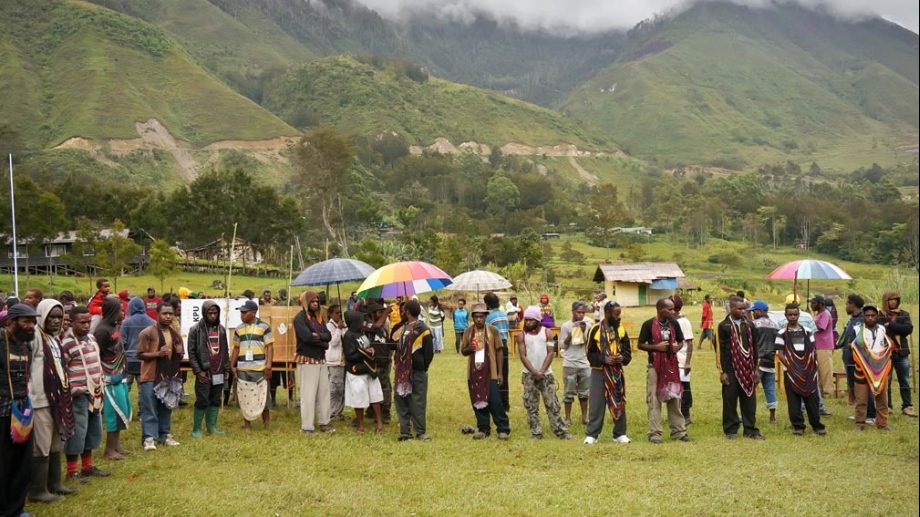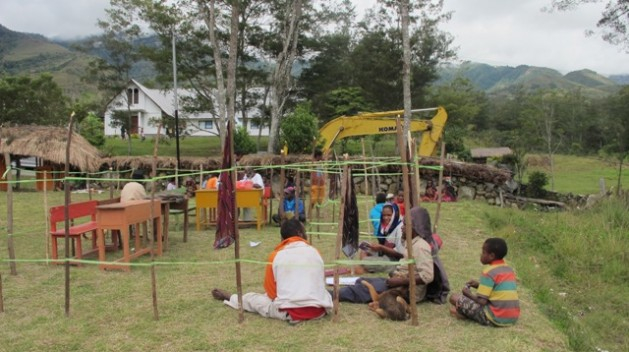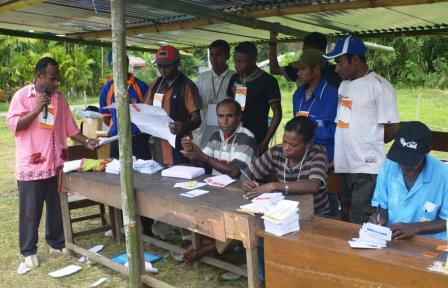When PDIP presidential candidate Jokowi visited Jayapura on 6 April, he told crowds that on election day he would “look first to Papua”, where polls close two hours ahead of those in Jakarta. But in truth, we’ll be waiting quite a while for an idea of the results in a province with no local quick counts or exit polls–the provincial elections commission says there’ll be no word until the end of April. The voting itself isn’t even quite finished: the last handful of 41 subdistricts where voting materials had not shown up on election day were due to conduct voting today. But if we don’t yet know how the results turned out, press reports give us some insight into the many different methods that Papuans used to register those votes.
The challenges to realising fully free and fair elections are legion in Papua and they aren’t only logistical–problems that exist elsewhere are generally even more extreme. Voter lists are routinely inflated by large margins (the full provincial voter list already exceeds the total 2010 population figure by over ten per cent, with the greatest variation in the central highland areas). Voter education rates are low, but more importantly, so are basic literacy rates in many parts of the highlands, where even finding literate workers to staff polling stations is a real problem. There are few of the young and technologically savvy who might play an informal role in checking and reporting fraud. Independent monitoring is almost non-existent and news coverage is spotty.
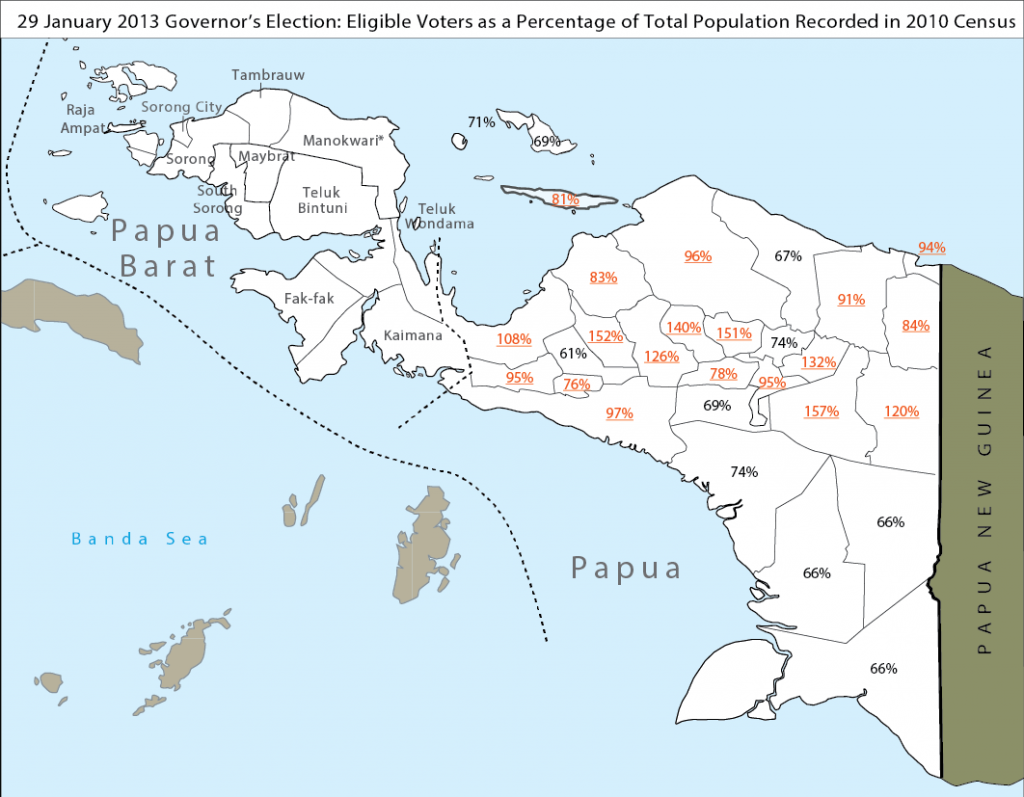
The number of eligible voters in the January 2013 Governor’s election expressed as a percentage of the total population recorded in the 2010 census. The number on the voter rolls has since increased in many areas. Click to enlarge. (Source: IPAC)
Adding to these variations on national challenges is one that is homegrown: the use of the “noken system” of voting in parts of Papua’s highlands. The name is misleading–first and foremost because it is not a system: noken involves no written rules, no uniform practices and no minimum technical standards for how votes should be recorded. Second, the noken–a traditional bag made from bark and used widely in the highlands for a range of daily needs–is often peripheral to the process. In some areas of the highlands, voters place their ballots in noken bags hung from the necks of other villagers (see photo below).
But elsewhere, voters don’t even show up on polling day, leaving community leaders to make a decision on how votes will be apportioned among candidates and then simply write down the tally and send it up to subdistrict level (a directive by the provincial elections commission in early 2013 said a punched ballot would have to be produced for each vote in order to be considered valid, but that voters did not necessarily have to do the punching themselves).
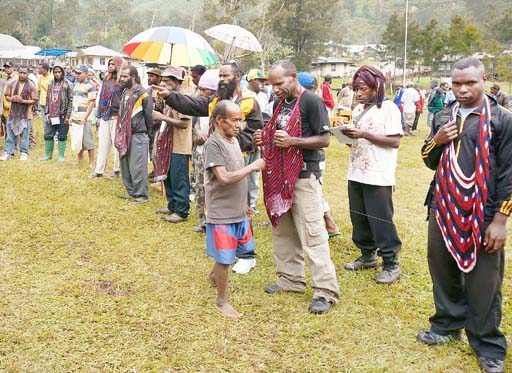
Where ‘noken’ voting gets its name from: placing votes inside a ‘noken’ bag in the highlands. Photo: Antara
While different people use the term in different ways, noken voting is best understood as meaning bloc voting and an avenue towards fraud. Its proponents are defending the abandonment of two fundamental principles of Indonesian elections: the right to a secret ballot (when present, the noken bags are not shielded by any screen), and the freedom of each individual to decide his or her vote (community leaders make the decision instead). Where the physical act of voting takes place, it is often merely for show.
If noken clearly violates these two principles, the unfortunate defender of its legitimacy is the Constitutional Court, which upheld variations on the practice in three decisions issued between 2009 and 2012 (it refers variously to “noken”, “voting by acclamation” or “community agreement” (noken, aklamasi, kesepakatan warga). The Court argued that it had to balance the right to a free and secret vote against the need to preserve the rights of communities to uphold customary (adat) traditions. Here and in other decisions, the Court seems to take the existence and legitimacy of adat norms largely at face value, though some dispute whether bloc voting can really be considered an important part of highlanders’ adat.
Combined with the inflation of voter rolls, this system of bloc voting can be mobilised to dramatic effects. In the January 2013 governor’s election, it produced 100 per cent “turnout” rates in nine highland districts in the January 2013 governor’s election (compare to roughly 60 per cent in the urban coastal areas of Jayapura city and Merauke), and played a key role in the election of highlander Lukas Enembe. A dramatic increase in the voter rolls in the highlands meant that two-thirds of the total vote came from the highlands; an area that recorded no more than half the province’s population in census figures.
As this year’s elections approached, the elections commission announced it would not support noken voting in the parliamentary polls because there was no regulation for it. There were immediate complaints from highlander politicians in particular; the regional police commander gave contradictory comments on whether the practice would go ahead while some local officials, like the bupati of Jayawijaya district, boldly announced they would ignore the KPU. The head of the oversight body (Bawaslu) said it was clear that noken would be used in the highlands no matter what, because clan structures were so influential. Even the provincial election commission head suggested that someone take the issue up with the Constitutional Court, because it would likely be struck down.
We will get more of a sense of where noken was used once detailed kabupaten-level results are in. The telltale signs: 100 per cent turnout (or more), a huge number of votes for one candidate and a token number of votes for others.
In the meantime, the Jakarta Post led on Friday with a photo of voters placing ballots in noken bags hung around villagers’ necks in Lanny Jaya. A friend wrote of polling stations in Wamena where noken were being used, but only made available for a handful of local legislative candidates (there was no way to vote for anyone else). In some polling stations, noken were only provided for parties who had witnesses present.
In several other polling stations in Wamena, voters arrived to find there were no ballots available for the district-level assembly–they’d already been punched by polling station staff (polling will now be reconducted at six polling stations). In Bokondini, Tolikara, Brimob reinforcements were sent in after tensions rose between different candidates unhappy with the number of votes they’d been given through a noken agreement.
Inflated voter rolls also continued to pose problems. From Nduga, where one man was killed in 2012 in a dispute between the district government and the district assembly over inflation of the voter rolls, come reports that many (and perhaps all?) civil servants were barred from voting due to a limited number of ballots (for more background to the Nduga case, see our September 2013 IPAC report). The reason for the insufficient number of ballots was that the elections commission had decided to assign a fixed average of 4,587 voters to each of the 32 subdistricts in Nduga, in an effort to “avoid conflict” (one effect of this approach would be to ensure that each subdistrict’s votes had roughly equal influence in the district-level election).
While the customary basis for noken voting is based on the adat of the Papuan highlands, Papuans elsewhere are claiming the right to use bloc-voting systems. Jayapura newspaper Suluh Papua carried reports of a polling station on Yapen island, in the Cenderawasih Bay, where voters were given ballots for national and provincial level contests but not for the district-level assemblies. That’s because–the village head explained–he, the polling station staff and all the party witnesses had already agreed to give 100 votes to the PAN party candidate and to distribute the remaining 75 among the other parties. They even agreed to use the reserve ballots (every polling station receives an extra two per cent) for the PAN candidate. The village head repeatedly said this practice was “in accordance with the rules”.
What’s clear is that “the rules” need to be better defined and then more consistently upheld. National election law and regulations need to more explicitly address the subject of bloc voting and existing regulations need to be upheld in order to prevent its occurrence. Voter education needs to be stepped up across Papua with an eye towards allowing voters a free and informed choice.
But the need to improve the quality of elections in Papua is not just a technical issue–it is also political. Elections have been a problem in Papua since the infamous 1969 Act of Free Choice, the basis for Indonesia’s formal incorporation of the former Dutch colony of New Guinea, when the Indonesian organisers rejected plans to hold a direct vote in favour of enfranchising a far more manageable 1,025 hand-picked community leaders. That vote was the subject of serious military intimidation–something not at all present now. But if elections in some parts of Papua are still only about voters endorsing choices that their leaders have already made, then democracy in these areas has not advanced enough in the last 45 years. More needs to be done to bring standards here in line with the rest of the country.
………
Cillian Nolan is the Deputy Director of the Jakarta-based Institute for Policy Analysis of Conflict (IPAC).
 Facebook
Facebook  Twitter
Twitter  Soundcloud
Soundcloud  Youtube
Youtube  Rss
Rss 